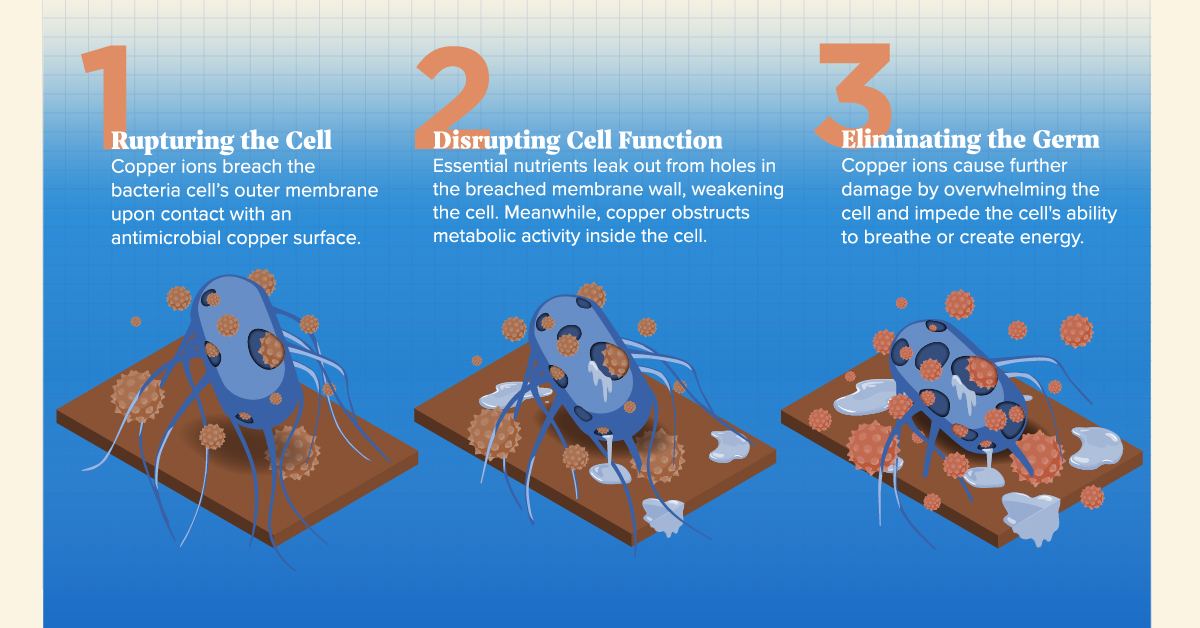Antimicrobial Copper: The Germ-fighting Metal
The following content is sponsored by Trilogy Metals.

Antimicrobial Copper: The Germ-fighting Metal
Copper has a wide range of uses in electronics, infrastructure, and energy technologies. The red metal is virtually everywhere, from the wires in our devices to the buildings we live in.
However, copper’s medicinal applications, which go back thousands of years, aren’t as widespread in the modern world.
In this infographic from our sponsor Trilogy Metals, we explore copper’s ability to fight bacteria and its expanding role in modern healthcare.
Dr. Copper: How Copper Fights Germs
Copper is naturally antimicrobial, and ancient civilizations recognized this property. The Egyptian Smith Papyrus recorded copper’s first medical use thousands of years ago. Since then, several generations have passed down their knowledge about copper’s medicinal uses.
But how does copper kill germs?
According to the Copper Development Association, copper surfaces affect bacteria in a series of sequential steps:
#1: Breaching the Cell
Every bacterium’s outer cell membrane is characterized by an electrical micro-current, known as the “transmembrane potential”. It is suspected that when a bacterium is exposed to a copper surface, it leads to a short-circuiting of the current in the cell membrane, which weakens the membrane and creates holes.
Localized oxidation is another mechanism by which copper breaches bacterial cells. This occurs when a copper ion comes into contact with a protein or fatty acid from the bacterium’s cell membrane in the presence of oxygen, which causes oxidative damage to the cell membrane.
#2: Disrupting Cell Function
Once copper breaches the cell membrane, essential nutrients start leaking out of the cell. Simultaneously, an increasing number of copper ions enter the cell and obstruct essential metabolic activity. This reaction is catalyzed by enzymes, and as excess copper binds to the enzymes, their activity grinds to a halt.
#3: Eliminating the Germ
With an overwhelming amount of copper ions obstructing the bacterium’s metabolism, it cannot “breathe”, “eat”, or “create energy”, which effectively eliminates the bacterium.
Certified Copper
Over 500 antimicrobial copper alloys are registered with the U.S. Environmental Protection Agency (EPA). This means that antimicrobial copper alloys passed the EPA’s performance standard for antimicrobial efficacy of solid touch surfaces, and it’s safe to say that antimicrobial copper kills 99.9% of certain bacteria within two hours. But this does not tell the full story.
The true value of antimicrobial copper lies in its ability to kill bacteria continuously after repeated contamination events. This means that antimicrobial copper provides continuous protection against bacteria without wearing out.
However, the EPA notes that the use of a copper surface is not a substitute for standard infection control practices, and copper alloys do not necessarily prevent cross-contamination. Hence, users must continue to follow current infection control practices, including cleaning and disinfection of environmental surfaces.
Copper vs. COVID-19
High-touch surfaces play a major role in spreading COVID-19, and copper can help stop the spread.
According to a study from the New England Journal of Medicine, the SARS-CoV-2 virus can live up to three days on plastics, compared to four hours on copper surfaces. Additionally, based on testing against harder-to-kill viruses, the EPA expects antimicrobial copper surfaces to eliminate 99.9% of SARS-CoV-2 within two hours.
Copper’s ability to fight bacteria and germs enables antimicrobial applications across several industries.
The Applications of Antimicrobial Copper
From healthcare to transportation, virtually every sector can improve hygiene by installing antimicrobial copper on high-touch surfaces.
For example, a trial by TransLink, Teck Resources Ltd., and Vancouver Coastal Health found that copper kills up to 99.9% of bacteria on high-touch surfaces in public transit vehicles. This suggests that simply installing antimicrobial copper on handrails, door handles, and poles can provide people additional protection against germs.
In addition, copper can make for a highly effective antimicrobial surface in healthcare settings where the risk of infection is higher. A study by Schmidt et al., published in the Applied and Environmental Microbiology Journal, found that hospital beds with copper surfaces harbored 95% fewer bacteria than conventional beds.
Furthermore, sports facilities, airports, and restaurants have also made use of antimicrobial copper as a protective layer. As more industries recognize copper’s antimicrobial properties, its applications will likely continue to grow.
A New Meaning for Dr. Copper?
Thousands of years after the Ancient Egyptians, Greeks, and Romans, copper’s medicinal properties are resurfacing.
With rising awareness around hygiene practices, especially in healthcare settings, the market for antimicrobial coatings is expanding. Given copper’s effectiveness in eliminating harmful bacteria, the term “Doctor Copper” may find a new meaning as its antimicrobial uses grow.
-

 Sponsored3 years ago
Sponsored3 years agoMore Than Precious: Silver’s Role in the New Energy Era (Part 3 of 3)
Long known as a precious metal, silver in solar and EV technologies will redefine its role and importance to a greener economy.
-

 Sponsored7 years ago
Sponsored7 years agoThe History and Evolution of the Video Games Market
Everything from Pong to the rise of mobile gaming and AR/VR. Learn about the $100 billion video games market in this giant infographic.
-

 Sponsored8 years ago
Sponsored8 years agoThe Extraordinary Raw Materials in an iPhone 6s
Over 700 million iPhones have now been sold, but the iPhone would not exist if it were not for the raw materials that make the technology...
-

 Sponsored8 years ago
Sponsored8 years agoThe Industrial Internet, and How It’s Revolutionizing Mining
The convergence of the global industrial sector with big data and the internet of things, or the Industrial Internet, will revolutionize how mining works.


